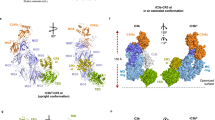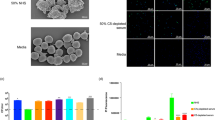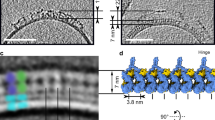Abstract
THE hinge region links the two Fab arms to the Fc portion of the IgG molecule. It mediates flexibility to the molecule and serves as a connecting structure between the two heavy chains. In addition it provides space between the Fab and Fc parts. All three properties have been proposed to be important for the ability of IgG to initiate complement activation leading to complement-mediated cell lysis (CML)1. Here we report the construction of a hinge-deleted mouse–human chimaeric IgG3 molecule with specificity for the hapten NIP (3-iodo-4-hydroxy-5-nitrophenacetyl), HM-1. HM-1 lacks the genetic hinge, but has an introduced cysteine between Ala 231 (EU numbering) and Pro 232 in the lower hinge encoded by the CH2 exon. The introduced cysteine forms a disulphide bond between the two heavy chains of the molecule. In CML, HM-1 shows a greater activity than IgG3 wild type. This is the first time an IgG molecule without a genetic hinge has been found to be active in CML. We conclude that the hinge functioning as a spacer is not a prerequisite for complement activation. Rather, its major role seems to be to connect the heavy chains to each other in the amino-terminal part of CH2. Because HM-1 is expected to have low Fab–Fc flexibility, this molecular feature is probably of no importance for complement activation.
This is a preview of subscription content, access via your institution
Access options
Subscribe to this journal
Receive 51 print issues and online access
$199.00 per year
only $3.90 per issue
Buy this article
- Purchase on Springer Link
- Instant access to full article PDF
Prices may be subject to local taxes which are calculated during checkout
Similar content being viewed by others
References
Feinstein, A., Richardson, N. & Taussig, M. J. Immun. Today 7, 169–174 (1986).
Sandlie, I., Aase, A., Westby, C. & Michaelsen, T. E. Eur. J. Immun. 19, 1599–1603 (1989).
Dangl, J. L. et al. EMBO J. 7, 1989–1994 (1988).
Duncan, A. R. & Winter, G. Nature 332, 738–740 (1988).
Nezlin, R. Adv. Immun. 48, 1–40 (1990).
Burton, D. R. Molec. Immun. 22, 161–206 (1985).
Michaelsen, T. E., Aase, A., Westby, C. & Sandlie, I. Scand. J. Immun. 32, 517–528 (1990).
Norderhaug, L. et al. Eur. J. Immun. 21, 2379–2384 (1991).
Tan, L. K., Shopes, R. J., Oi, V. T. & Morrison, S. L. Proc. natn. Acad. Sci. U.S.A. 87, 162–166 (1990).
Klein, M. et al. Proc. natn. Acad, Sci. U.S.A. 78, 524–528 (1981).
Deutsch, H. F. & Suzuki, T. J. Immun. 107, 929–930 (1971).
Marquart, M., Deisenhofer, J. & Huber, R. J. molec. Biol. 141, 369–391 (1980).
Ito, W. & Arata, Y. Biochemistry 24, 6467–6474 (1985).
Rajan, S. S. et al. Molec. Immun. 20, 787–899 (1983).
Silverton, E. W., Navia, M. A. & Davies, D. R. Proc. natn. Acad. Sci. U.S.A. 74, 5140–5144 (1977).
Schneider, W. P., Wensel, T. G., Stryer, L. & Oi, V. T. Proc natn. Acad. Sci. U.S.A. 85, 2509–2513 (1988).
Michaelsen, T. E. Scand. J. Immun. 5, 1123–1128 (1976).
Seegan, G. W. et al. Proc. natn. Acad. Sci. U.S.A. 76, 907–911 (1979).
Kunkel, T. A., Roberts, J. D. & Zakour, R. A. Meth. Enzym. 154, 367–382 (1987).
Sanger, F., Nicklen, S. & Coulson, A. R. Proc. natn. Acad. Sci. U.S.A. 74, 5463–5467 (1977).
Neuberger, M. S. et al. Nature 314, 268–270 (1985).
Potter, H., Weir, L. & Leder, P. Proc. natn. Acad. Sci. U.S.A. 81, 7161–7165 (1984).
Neuberger, M. S. EMBO J. 2, 1373–1378 (1983).
Laemmli, U. K. Nature 227, 680–685 (1970).
Aase, A., Sandlie, I., Norderhaug, L., Brekke, O. H. and Michaelsen T. E. Eur J. Immunol., (in the press).
Author information
Authors and Affiliations
Rights and permissions
About this article
Cite this article
Brekke, O., Michaelsen, T., Sandin, R. et al. Activation of complement by an IgG molecule without a genetic hinge. Nature 363, 628–630 (1993). https://doi.org/10.1038/363628a0
Received:
Accepted:
Issue Date:
DOI: https://doi.org/10.1038/363628a0
Comments
By submitting a comment you agree to abide by our Terms and Community Guidelines. If you find something abusive or that does not comply with our terms or guidelines please flag it as inappropriate.



